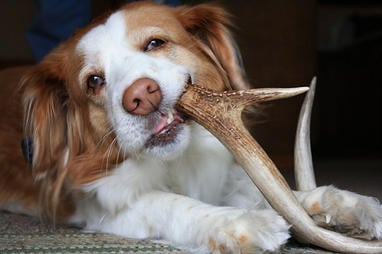Deer sheds

This is only necessary in the autumn and early winter during the breeding season. During the “rut,” the bucks are aggressive toward other males and use the antlers to duel for supremacy. They are much more sociable with one another during the rest of the year when they aren’t trying to impress the does or battle for dominance.
When the rutting season is over, the antlers are no longer needed so they are shed. In our area, this occurs from January through April. Bucks often rub their antlers against trees to encourage them to fall off. When they do fall off, the antlers break off at the pedicle, a permanent knob of bone on the skull, and fresh skin grows over it. While it takes months to grow antlers, the shedding process is completed in only a few weeks.
While both antlers are sometimes shed at the same time, it is more often the case that they are lost individually. For many hikers and naturalists finding a shed antler is a special event since they aren’t quite as easy to find as you might think. Antlers are often shed along the narrow trails deer make through the underbrush when they inadvertently rub against trees and shrubs and when they bump into things as they bend down to feed. In most cases, these are places humans don’t usually travel.
Besides looking in the right places, a sharp eye helps. Broken branches that have lost their bark may distract an antler hunter and antlers are rarely left completely in the open. Leaves and twigs frequently cover over parts of an antler, making it harder to discern as well.
Though antler bone is pretty tough it doesn’t last forever. Left on the forest floor, old antlers don’t last for long. Rodents such as squirrels, mice and chipmunks gnaw on the antlers to keep their teeth in shape and for the calcium and other minerals they contain. If not consumed by rodents, antlers suffer the consequences of other natural processes. Drying causes the bone to split and splinter while too much moisture will encourage bacteria and fungi to decay the bone. The best antlers are collected soon after shedding.
 Since deer mate in the fall, the males begin to grow antlers in late spring. It takes between three to four months for the antlers to grow to full size.
Since deer mate in the fall, the males begin to grow antlers in late spring. It takes between three to four months for the antlers to grow to full size.
The antlers grow from permanent skin-covered knobs of bone on the buck’s head called pedicles. While the antlers are growing, they are covered by a thin layer of sensitive skin known as velvet. The velvet skin is full of blood vessels that bring the vitamins and minerals needed to build up bone. When the antlers have reached full size, the blood flow in the velvet stops. Without blood flow, the velvet dries up and falls off.
Scars of shredded bark left on tree trunks are known as back rubs since they are made by bucks in the autumn. These marks begin to be made just as the antlers are finishing their development.
The vast majority of buck rubs are made by the largest and strongest bucks after they have lost the velvet. Glands under the skin on the forehead leave scents on the trees when the antlers shred the bark. Each buck leaves his own particular scent. The rubs are markers of the buck’s territory and act as a chemical message to younger male deer as well as the females.
To the does, the scents act as an attractant to encourage their interest in the buck. As far as the younger males are concerned, the scent of the dominant buck warns them against starting trouble.
Buck rubs are usually observed at a height of two to three feet above the ground on trees that have smooth bark and have no lower branches. Red maple, black cherry, staghorn sumac and willows are often chosen for buck rubs. Tougher trees such as ironwood and beech are rarely chosen.
Reindeer are the only deer where the does have antlers
Antlers are grown by all members of the deer family. This includes the caribou, moose and elk as well as the white tail deer found here on Staten Island. Only males grow horns, except for reindeer in which the females also have antlers which they use to dig for vegetation under snow. Reindeer bucks shed their antlers in early December while the does keep them about a month longer.

If you’re looking for someone who’ll go bananas every time they see your dog or cat, knows them so well they notice one hair out of place, speaks their language, knows their favorite treat AND movie and most of all become their second favorite human in the whole world, then you’ve found the right person! Lisa resides in Westerleigh and is a Dogtec Certified Dog Walker, NYC Certified in Animal Care and Handling, FEMA Animals in Disasters Certified, a Trap-Neuter-Return (TNR) and Feral Colony Care Specialist and Red Cross Pet First Aid Certified.

